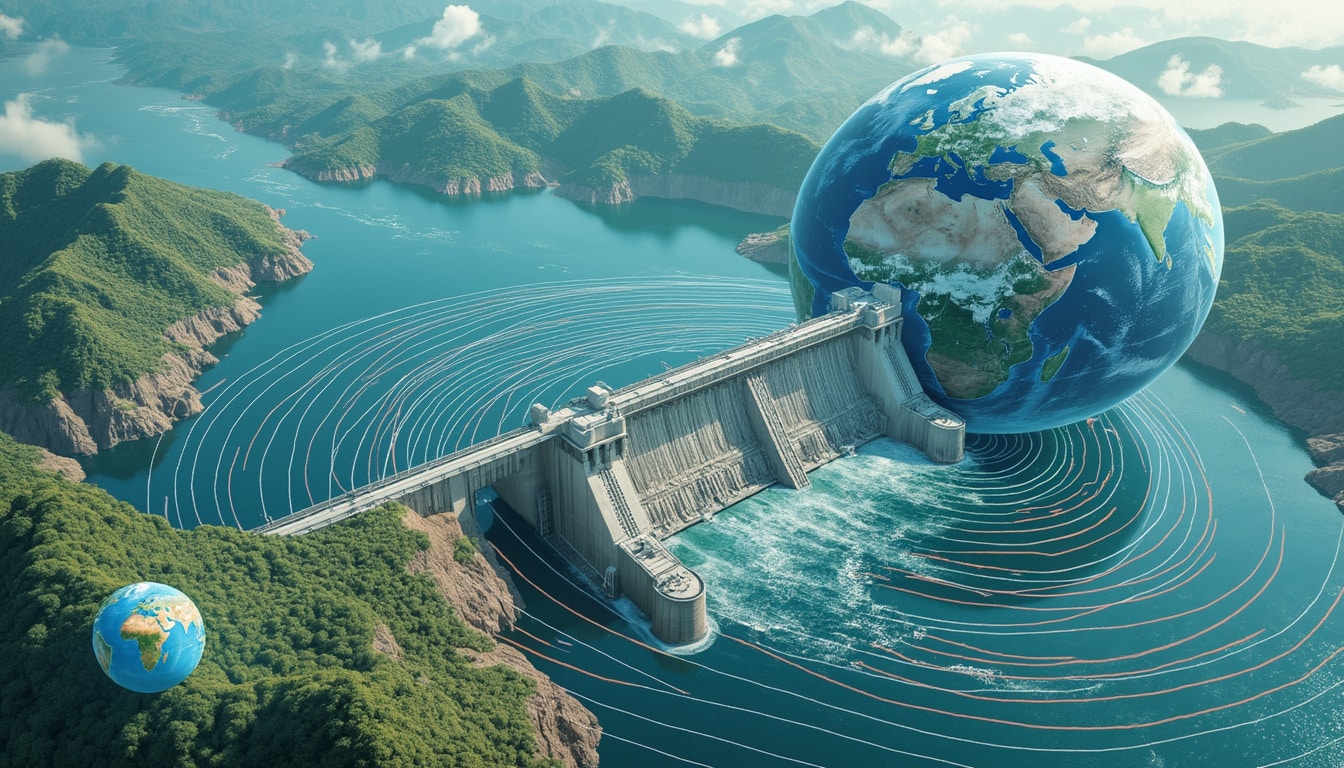Recent discussions have emerged surrounding the implications of colossal human constructions on our planet, particularly focusing on the impact of China’s Three Gorges Dam. NASA scientists have unveiled surprising findings indicating that this monumental structure is actually contributing to a deceleration in Earth’s rotation. According to Dr. Benjamin Fong Chao at NASA’s Goddard Space Flight Center, the dam has led to an increase in the length of the day by 0.06 microseconds. This phenomenon invites curious thoughts about how our advancements in engineering can affect natural processes on a global scale and what it means for our daily lives.
The Three Gorges Dam, standing 2,335 meters long and 185 meters high, is not only the largest hydroelectric power station in the world but also a vital cog in China’s energy strategy. Storing water with significant mass at a height of 175 meters creates enough energy to shift Earth’s moment of inertia. This nuanced change, while minuscule on the surface, demonstrates the potential consequences of human activity on planetary systems. Understanding these insights can provide a glimpse into the interconnectedness of technology and natural elements.
The Science Behind Earth’s Rotation and Construction Impact
Understanding how human-made structures can impact the natural world requires a closer look at mass distribution and its effects on rotation. Dr. Chao explains that any shift of mass alters Earth’s rotation dynamics, akin to a figure skater adjusting their arms to control their spin. The large volume of water trapped by the Three Gorges Dam has caused a slight alteration in the distribution of Earth’s mass, affecting its rotational speed.

Understanding Mass Distribution
The underlying principle of mass distribution is rooted in physics. When mass is relocated, inertia of the Earth varies, fundamentally altering its rotation. Research indicates that the Three Gorges Dam’s massive reservoir has effectively lengthened the Earth’s day by 0.06 microseconds. Although this change seems negligible, it accumulates over eons, leading to observable consequences in our cosmic calendar. According to Dr. Chao, if one were to quantify this, it translates to just over three additional days throughout the entire age of the universe.
Implications for Timekeeping and Daily Life
As we consider the implications of a 0.06 microsecond increase in the Earth’s rotational period, one might ponder its relevance in everyday life. For instance, in the grand scheme, this time span is less than the blink of an eye. Yet, it raises questions about how our planet’s timekeeping and calendars could shift, particularly for scientific measurements and technological systems reliant on precision timing. The effects, albeit minor, serve as a reminder of how interconnected our activities are with the planet’s own rhythm.
Technical Innovations and Global Perspective
The advent of large infrastructure projects like the Three Gorges Dam marks significant technological milestones, showcasing human engineering prowess. However, alongside these achievements lies a responsibility to understand their planetary impacts. As technologies evolve, the opportunity arises to rethink designs and implementations that honor our connection with Earth.
The Three Gorges Dam: A Beacon of Energy Production
The sheer scale of the Three Gorges Dam as a renewable energy source cannot be overstated. With an impressive capacity of 22,500 megawatts, it generates an equivalent power output of about 15 nuclear reactors. Such generation capabilities significantly reduce coal dependency and contribute to decreasing carbon emissions, aligning with global energy sustainability goals. The dam thus plays a dual role; it supports energy needs while posing questions about ecological balance.
Environmental Impact Assessments
The construction of large-scale hydroelectric projects necessitates vast environmental considerations. While the dam aids renewable energy transitions, concerns exist regarding its effect on local ecosystems and water wildlife. Careful assessments and active management strategies are essential to mitigate adverse impacts while maximizing energy benefits. As humanity endeavors towards sustainable practices, understanding these environmental impacts will shape future projects across the globe.
Comparative Analysis with Other Megastructures
Engaging in comparative analyses of megastructures like the Three Gorges Dam can underscore lessons learned. Projects developed by companies such as SpaceX, Blue Origin, and Boeing prioritize advancements that adhere to scientific and ecological standards. Each initiative—whether building cycling highways or spaceports—reflects an increasing awareness of our responsibility towards both human progress and planetary welfare.
The Role of Innovation in Environmental Balance
Innovative engineering has immense potential to pivot towards sustainable practices. Companies such as Northrop Grumman, Raytheon, Planet Labs, and Rocket Lab are redefining industry standards while promoting environmentally conscious systems. Future infrastructure projects can borrow insights from successful implementations to mitigate adverse consequences on natural dynamics, aiming for a harmonious coexistence.
Cultural and Social Implications of the Findings
As news about the Three Gorges Dam’s impact reverberates around the globe, societal discussions facilitated by platforms like Reddit showcase diverse opinions. Many users express astonishment at the extent to which human action can influence nature, leading to philosophical considerations on our habits and practices as a civilization. This dialogue fosters awareness and encourages participation in creating sustainable spaces.
Public Perception and Awareness
The revelation of the dam’s influence on Earth’s rotation has ignited interest and dialogue on a global scale. Public perception of such projects often oscillates between admiration and concern. As large-scale constructions are scrutinized, educational efforts are critical to ensure people grasp their complexities and the dualities of their impacts. Creating forums for discussions will empower individuals to hold informed views about ongoing and future projects.
The Role of Education in Sustainability
To enhance societal understanding surrounding technological impacts on the environment, educational initiatives play a pivotal role. Science curricula, environmental programs, and outreach activities foster awareness among younger generations, preparing them to navigate the delicate balance between development and ecological stewardship. Each individual must be equipped with knowledge and tools to contribute meaningfully to discussions around sustainability.
Responsibility and Future Planning
Ultimately, understanding the consequences of ambitious projects like the Three Gorges Dam emphasizes our responsibility in future endeavors. As facilities like SpaceX’s planned Mars colonization bring forth innovative possibilities, it is imperative to advocate for policies that prioritize ecological integrity. Future generations will look back on our actions and measure the legacy we’ve crafted—or compromised—through our technological explorations.
The Bigger Picture: Earth’s Rotation and Other Factors
While the impact of the Three Gorges Dam has captured attention, it leads to a pressing inquiry: how do other factors contribute to Earth’s rotational dynamics? Several elements, including geological activities, atmospheric conditions, and planetary shifts, play essential roles in this intricate balancing act. Understanding these components is vital when considering any human influences on Earth’s system.
Geological Impacts on Earth’s Spin
Geological movements, such as tectonic shifts, heighten or mitigate Earth’s spin. Events like earthquakes can redistribute mass within the planet, causing micro adjustments in rotation. As geophysicists study these phenomena, our understanding of the interplay between geological occurrences and human infrastructure can guide proactive measures forwise construction practices.
The Future of Time Measurement
The findings unveiled by NASA prompt discussions on the future of timekeeping. With ongoing advances in technology, the need for precise measurements also broadens. Collaborations among scientific communities and public institutions, such as NASA and Lockheed Martin, can influence technological advancements that aim to balance human progress and degrees of planetary rotation.
Innovative Solutions for Earth Maintenance
As human advancements progress, innovative approaches are essential in maintaining balance within Earth’s systems. Companies like Virgin Galactic are striving for the frontiers of space exploration, paving the way for sustainable off-world habitats. Challenges on Earth can serve as a springboard for imaginative solutions in space technologies, extending more profound ecological understanding towards future habitations.
Perspectives Moving Forward
Considering the implications of constructions like the Three Gorges Dam encourages a broader perspective on large-scale projects worldwide. As humanity forges ahead, the balance between engineering marvels and ecological awareness is paramount. With the observations made by NASA and discussions proliferating online, our responsibilities toward Earth’s systems gain renewed urgency. The interdependence of technological advancement and natural systems serves as a call to action for thoughtful consideration of future endeavors.





Leave a Reply